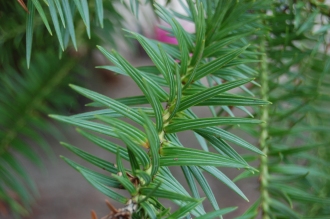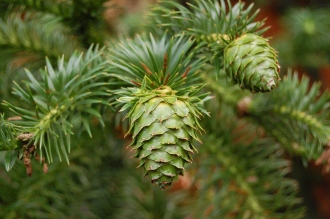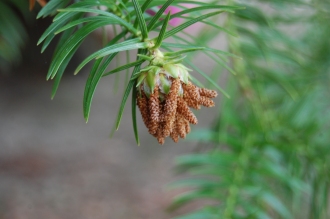Position: Full sun to partial shade
Flowering period: Insignificant, male flowers in May
Soil: Moist, well-drained
Eventual Height: 25m
Eventual Spread: 9m
Hardiness: 6b, 7a, 7b, 8a, 8b, 9a, 9b
Family: Cupressaceae
Cunninghamia lanceolata is an evergreen coniferous tree with a columnar, upright habit with drooping branches. The leaves of the tree are softly spined, leathery, stiff green to blue green in colour and are needle like, whilst being spirally arranged. They are 2 – 7 centimeters long and 3 – 5 millimeters broad at the base, bearing two white or greenish white stomatal bands underneath and sometimes also above. The tree is monoecious, the pollen cones are small and inconspicuous and produced in May. The seed cones are green initially, turning brown with age. The bark is dark grey to reddish brown, longitudinally fissured , then cracking into irregular flakes and exposing an aromatic, yellowish or reddish inner bark. The branches are whorled, spreading and pendulous at the ends.
Cunninghamia lanceolata, commonly known as Chinese Fir, is native to China, Taiwan, and northern Vietnam, where they can reach heights of up to 50 – 55 metres. It is grown as an ornamental tree in many parks around the UK. The tree was discovered in 1701 but not introduced into Britain for another century in 1804. This tree has historically been called Pinus lanceolata, Belis jaculifolia, Belis lanceolata, Cunninghamia chinensis, Cunninghamia sinensis, Cunninghamia unicanaliculata and Raxopitys cunninghamii. The wood of this tree is prized and it will tolerate coppicing.
The etymological root of the binomial name Cunninghamia is named after the British Doctor, Dr. James Cunningham, who introduced this species into cultivation in 1702. Lanceolata is derived from the Latin lancea ‘a light spear’ or ‘lance’ referring to the leaves of the tree.
Cunninghamia lanceolata may be useful to the landscape architect as a large, evergreen, attractive specimen tree in a parkland setting. It does not like exposure to drying winds.
Cunninghamia lanceolata prefers moist but well drained soil. It can tolerate most soil pH types.










“I at the same time requested that … the genus might be named Cunninghamia, to commemorate the merits of Mr. James Cunningham, an excellent observer in his time, by whom this plant was discovered; and in honor of Mr. Allan Cunningham, the very deserving botanist who accompanied Mr. Oxley in his first expedition into the interior of New South Wales, and Captain King in all his voyages of survey of the Coasts of New Holland.” -Robert Brown in appendix to Capt. Phillip P. King (1827) – Narrative of a survey of the intertropical and western coasts of Australia-